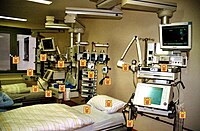
Photo from wikipedia
Objective Hospital-acquired infections (HAI) are a global problem and a major public health concern in hospitals throughout the world. Quantification of HAI is needed in developing countries; hence we describe… Click to show full abstract
Objective Hospital-acquired infections (HAI) are a global problem and a major public health concern in hospitals throughout the world. Quantification of HAI is needed in developing countries; hence we describe the results of a 2-year surveillance data in a tertiary hospital in Nigeria. Methodology This study is a 2-year review using secondary data collected at a tertiary referral center in northwestern Nigeria. The data was collected using surveillance forms modeled based on the Centre for Disease Control (CDC) protocol. Descriptive statistics were used to present results as frequencies and percentages. Result 518 patients developed HAI out of 8216 patients giving an overall prevalence of 6.3%. The mean age of the patients was 35.98 years (±15.92). Males constituted 281 (54.2%). UTI 223 (43.1%) was the most prevalent HAI. Overall, E. coli 207 (40.0%) was the most frequent isolates followed by P. aerugenosa 80 (15.4%). There was a high prevalence of cloxacillin resistant S. aureus (67.9%) and gram-negative rods resistant to third-generation cephalosporins. Trimethoprim-sulfamethoxazole resistance across the board was more than 90%. Conclusion There is a high burden of HAI especially UTI in our hospital with resistance to commonly used antibiotics documented.
Journal Title: Heliyon
Year Published: 2018
Link to full text (if available)
Share on Social Media: Sign Up to like & get
recommendations!